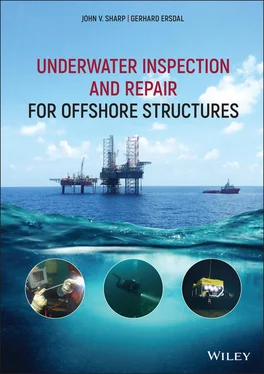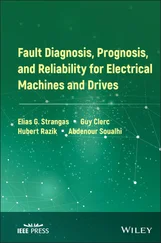The Background document to the Guidance Notes (HSE 1997) supported the limited problems to date but commented that this was probably a result of limited life, particularly for evidence of any corrosion of the steel reinforcement. Some problems with draw‐down had been found which were mentioned, due both to failure of the draw‐down system and accidental impact damage. Several platforms had suffered ship impact or impacts from dropped objects, with several cases where the damage had been minimal. Where damage had occurred, it had resulted in holes in cell roofs or a leg and in each case a repair had been undertaken. It was noted that the degree of marine growth had varied substantially between structures, some structures with almost no growth, others with extensive growth requiring cleaning.
The “Repairs” concrete section of the Guidance Notes stated that the accepted materials for repair offshore were concrete, cement grouts and mortars and epoxy resins. The importance of the ability of the repair material to bond to concrete, reinforcement or pre‐stressing ducts needed to be considered. The Guidance Notes also noted that when selecting a repair material for protection of the reinforcement against corrosion, the properties of the material to be considered should include permeability to water, presence of chloride ions and resistivity. An important factor is the durability of the repair material in the marine environment .
Repair of cracking in a concrete structure was addressed, with low viscosity epoxy resins being the usual material and the repair procedure should be established by trials.
Repairs to steel reinforcement were considered where the reinforcement has been damaged or cut away. The new reinforcement should either be lapped on to the existing reinforcement with a full bond length or connected by a suitable coupler.
Repairs to prestress were also addressed making the point that it is very difficult to establish the effectiveness of any damaged prestress, as this is to a large extent dependent on the bond with the grout in the cable duct. The effectiveness of any repairs to tendons which have been broken would require re‐stressing of the new or repaired tendons, which is not easy in a repair situation.
Repair of cracking in a concrete structure should utilise low viscosity epoxy resins, and the repair procedure should be established by trials.
2.5.4 NORSOK N‐005—Concrete Structures
NORSOK N‐005 (Standard Norge 2017b) has a special annexe covering inspection of concrete structures. This standard makes the point that concrete structures are normally damage tolerant because of their large dimensions and planning of inspections should take this into account. However, it also points out that ageing concrete structures in air may experience increasing amount of chloride ingress that may lead to corrosion of reinforcement in areas of poor‐quality concrete.
Specific requirements for data collection and management relating to concrete structures include:
operational criteria for caisson cells operated with differential hydrostatic pressure (drawdown) or normal hydrostatic pressure in cells;
operational criteria for cells used for oil storage and/or water ballast;
any reported repairs or discontinuities in the concrete from the fabrication phase. Specifically, repair of reported leakages in the concrete;
description of mechanical systems for operating the ballast water, oil filling and draw down systems in the storage cells; and
settlement and tilt monitoring.
Regarding evaluation of changes NORSOK N‐005 (Standard Norge 2017b) states that the following items are noted for concrete structures:
the condition of the concrete surface. Particularly the concrete surface above seawater level, due to weather exposure and chloride penetration, including core testing or dust samples of the concrete;
condition of coatings and linings, if present;
the cathodic protection of the concrete reinforcement; and
monitoring of crack development in highly utilized areas (e.g. near topside footings/bearings).
NORSOK N‐005 (Standard Norge 2017b) notes that the probability of failure of concrete structures is most often related to corrosion and less to fatigue damage. In addition, failure below the waterline is minimised by the presence of anodes providing corrosion protection to the steel reinforcement. As a result, large areas of a concrete structure such as caisson walls and shaft walls below water have relatively low probability and consequence of failure. Hence it is considered that a lower level of inspection for these structural components may influence the level and content of the inspection programme.
NORSOK N‐005 (Standard Norge 2017b) states that special attention should be given to areas of major importance for the structural integrity and for the atmospheric and splash zones, particularly where the risk of deterioration is highest. Areas of major importance are listed as complex connections such as wall‐dome connections, cell wall joints, columns to caisson connections and load bearing areas in the top of shafts. Construction joints, penetrations and embedments should also be considered.
NORSOK N‐005 (Standard Norge 2017b) notes that for inspection planning the potential failure mechanisms listed below should be taken into consideration. These can lead to typical types of failure, which include reinforcement corrosion, cracking, spalling and delamination and damaged coatings and abrasion:
construction‐related imperfections;
cracks due to formwork adhesion;
lack of reinforcement cover;
lack of concrete compaction;
unplanned construction joints;
chloride ingress;
corrosion of reinforcement behind cast‐in plates;
subsidence and seabed scouring;
internal defects in conjunction with oil storage such as leakage and biological activity;
leakage;
impact damage; and
freeze/thaw damage and ice abrasion.
In executing inspection of concrete structures NORSOK N‐005 (Standard Norge 2017b) states that programmes should be developed after the DFI resume has been delivered and updated periodically. A general statement is made that inspection planning should focus on verification of the condition of the structural components so that structural integrity can be maintained. It also states that taking into account the likely types of defects and damage which may develop, appropriate inspection methods should be developed. An example is given indicating that because delamination is often not visible on the concrete surface, hammer tapping may be needed to detect such areas.
NORSOK N‐005 (Standard Norge 2017b) notes that corrective maintenance should be implemented to prevent minor damage escalating into major damage. It is important to maintain steel reinforcements and pre‐tensioning to ensure structural functionality during the lifetime of the structure.
2.6 Discussion and Summary
As shown in this chapter, the first standards and recommended practices relating to structural integrity management were developed in the late 1960s and early 1970s. These standards were in practice inspection standards and often included inspection plans based on routine intervals inspired by ship rules. The parts of the structures that were regarded as major or important were inspected typically every fifth year. The offshore industry began to consider more cost‐effective and optimised inspection strategies in the late 1980s and methods for condition‐based and risk‐based inspection planning were developed and started to be used in practice. A broader view on integrity management was included in the development of the international standard ISO 19902 (ISO 2007), which commenced in 1993 and included a section on structural integrity management in early drafts. This standard was first issued in 2007, but the early drafts were used as the basis for structural integrity management in the interim. The process of inspection, data management, evaluation of findings and assessing the safety of the structure were included.
Читать дальше












